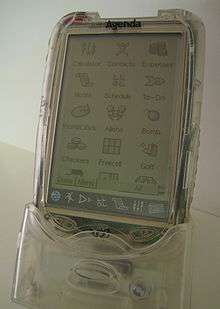Agenda VR3

The Agenda VR3 was the name of the first "pure Linux" Personal Digital Assistant (PDA),[1] released in May 2001 by Agenda Computing, Inc. of Irvine, California.[2]
History
The VR3 was unveiled at LinuxWorld Conference and Expo in August 2000[3] by Agenda Computing, which was at the time "a wholly owned subsidiary of the publicly traded electronics manufacturing giant, Kessel International Holdings, based in Hong Kong." A developer model, the VR3d, was available by December.[4]
By late 2001, the VR3's price dropped from $249 to $119 at some US retailers, which caused some to wonder whether the promised VR5 (a color handheld) was to be released, or Agenda Computing was closing shop.[5]
In April 2002, after the demise of Agenda Computing,[6] the Softfield Vr3 became available from Softfield Technologies of Toronto, Ontario, Canada.[7] As of July 2008, the device is still available from SoftField.[8]
Hardware
The VR3 was 4.5"x3.0"x0.8". It included a 2.25"x3.25", 160x240 pixel, monochrome, backlit LCD touchscreen. It utilized a 66MHz MIPS CPU with 8MB of RAM and 16MB of built-in Flash memory for storage.
For input, it included push buttons for actions (such as Page-Up and Down, and Left and Right), stylus-activated power on/off, on-screen hard buttons for launching applications and a built-in microphone jack.
It also included a notification buzzer, an LED notification light, an IrDA port and an RS232 port. It was powered by two AAA batteries, and connected to PCs via an RS232 cable, or a docking station that the cable connected to. Both contained a button for activating sync software.
Software
The VR3 came with a 2.4.0 version of the Linux kernel, XFree86, the Rxvt terminal emulator, the Bash shell,[9] and a user interface based on the FLTK GUI library.[10] It included on-screen keyboard and handwriting recognition software, a number of personal information management (PIM) applications (including an expense tracker, e-mail, to-do list, contacts list, and schedule), games, and other tools.
It is possible to telnet, FTP[11] and make remote X connections to the device.
Numerous applications were created by third-party developers, with the Agenda Software Repository listing nearly 200 titles by the end of 2003.[12]
References
- ↑ ""Agenda's agenda -- a Linux-based "Open PDA"""., LinuxDevices.com, retrieved July 17, 2008
- ↑ "Agenda begins delivering its VR3 Linux-PDAs (finally!)"., LinuxDevices.com, retrieved July 17, 2008
- ↑ "Linux-based PDA unveiled at LinuxWorld"., LinuxDevices.com, retrieved July 17, 2008
- ↑ "Linux on the Agenda VR3", TuxMobil, retrieved July 18, 2008
- ↑ "Agenda VR3 $119 at Fry's" Archived October 6, 2008, at the Wayback Machine. Linux Users' Group of Davis mailing list post
- ↑ "What's up with Agenda and the VR3 Linux PDA?"., LinuxDevices.com, retrieved July 17, 2008
- ↑ "Agenda VR3 compatible Linux PDA to sell for $105"., LinuxDevices.com, retrieved July 17, 2008
- ↑ "VR3 Linux PDA Specifications" page at Softfield.com, retrieved July 18, 2008
- ↑ "Review: Agenda VR3 Linux powered PDA", LinuxMedNews, retrieved July 18, 2008
- ↑ "A developer's perspective on Agenda's VR3 Linux PDA"., LinuxDevices.com, retrieved July 18, 2008
- ↑ "Linux palmtop revolution on its way", Linux.com, retrieved July 18, 2008
- ↑ Agenda Software Repository at agendawiki.com, retrieved via [Internet Archive#Wayback Machine|the Internet Archive Wayback Machine]